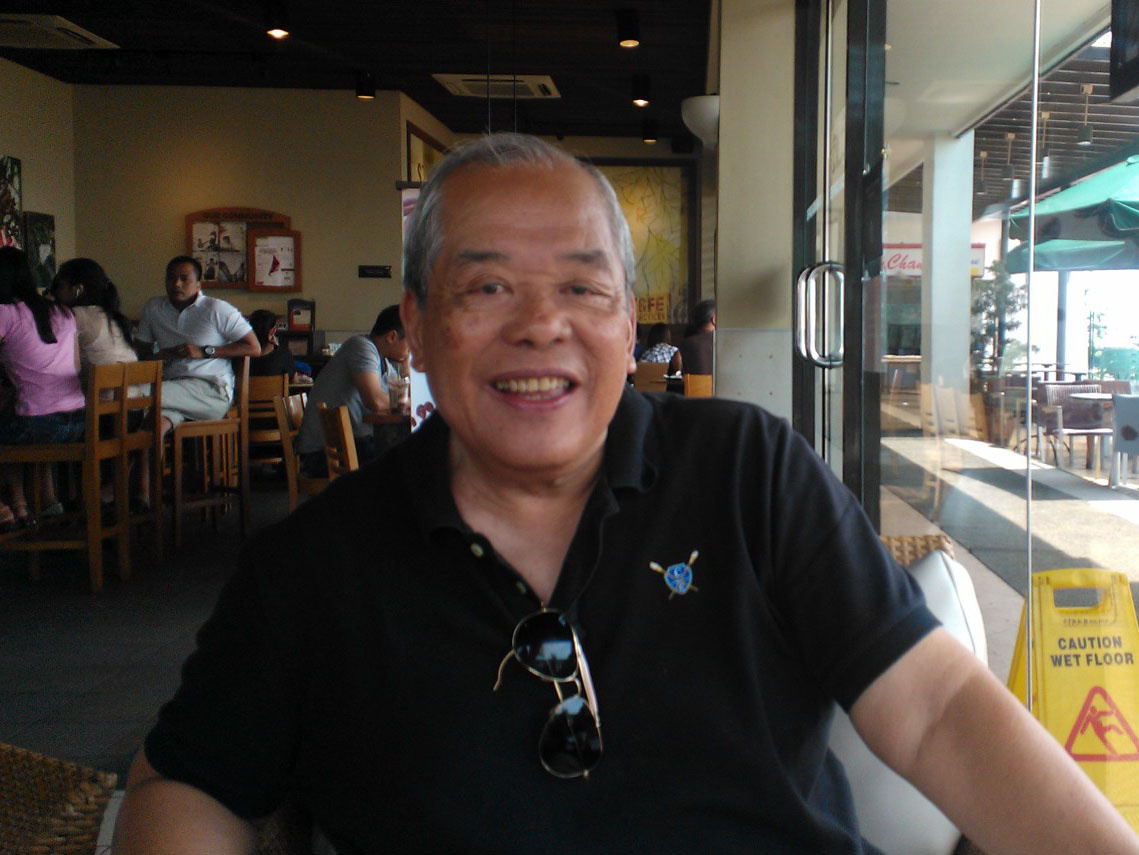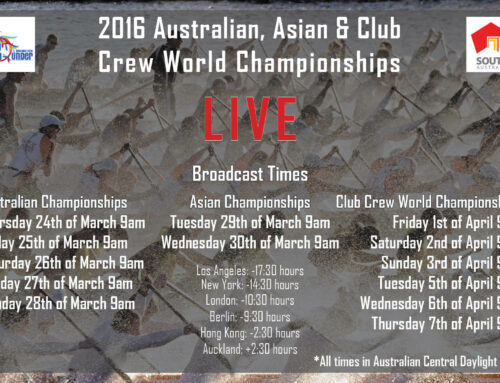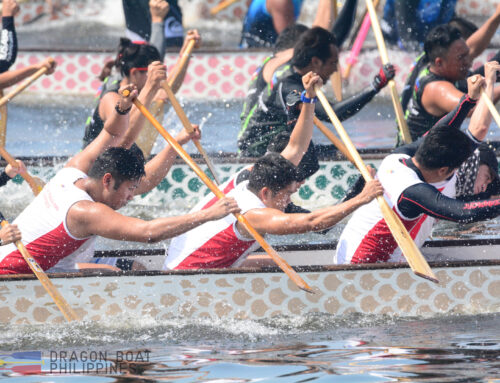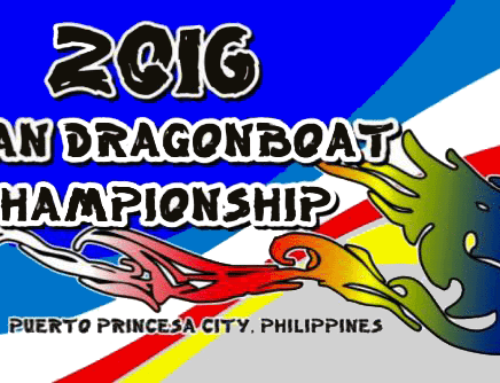The man who walks into the Starbucks at Harbor Square is clearly Mr. Benjie Ramos. His shirt, embroidered with two miniature oars, gives him away. As one of the founding fathers of dragon boat in the Philippines and a true renaissance man of boat sports, he agreed to meet up one sunny afternoon to give me and some teammates a crash course in local dragon boat history.
Ramos has a dignified yet cheerful demeanor. At first, it seemed that the current rift dividing the dragon boat community would dominate the conversation—“PDBF (the Philippine Dragon Boat Federation) will prevail,” declares Ramos, a PDBF founder and board member, in reference to the organization’s conflict with the Philippine Canoe-Kayak Federation (PCKF) over the governance of the sport. Fortunately, the inevitable discussion of internal politics was tempered by fascinating anecdotes from the sport’s earliest days.
“Ito Pala ang Dragon Boat, Kaya Natin ‘To!”
While dragon boating has a history that spans thousands of years, it owes its beginnings in the Philippines to a much younger institution, the 118-year-old Manila Boat Club (MBC). In 1986, some of its members, including Ramos, were invited by Hong Kong and Macau’s respective Tourist Associations to compete in their cities’ annual dragon boat festivals. A British expat and fellow member of the MBC encouraged them to join, telling them they would be “crazy to miss out on all the fun.” Ramos agreed to form a crew comprised of members of the Amateur Rowing Association of the Philippines (ARAP), despite the fact that they “didn’t know anything about dragon boat.”
Ramos describes the original Philippine crew as “a United Nations, with different nationalities—British, American, Chinese,” some of whom were friends invited at the last minute. They witnessed their first dragon boat races in Macau and thought, as they watched the heats, “Ito pala ang dragon boat, kaya natin ‘to, chicken ‘to!” The actual practice of the sport, though, wasn’t as easy as they expected. Dragon boat utilizes muscle groups and movements different from what they were used to in rowing, plus none of them, not even their coxswain, were skilled enough to steer the much larger boat. Ramos admits that at that time, “we weren’t that strong. Nakakangalay ang dragon boat.”
In a fortuitous turn of events, the Macau organizers postponed the rest of their festival for some days. They allowed the Philippine crew to stay behind and train for the upcoming Hong Kong races, with subsidized lodgings and other expenses.
A Show of Goodwill from Hong Kong
The Hong Kong festival’s highly competitive atmosphere proved challenging for the novice Philippine crew. Different countries were represented by formidable teams, with Singapore and Australia perceived as the strongest in those days. Ramos and company were even surprised that they did not finish in last place. “We were second to the last. We beat the Italian team,” he laughs.
The water posed its own dangers. “It’s difficult to paddle in Hong Kong harbor because the water is so choppy. In fact, we capsized,” says Ramos. Some teams actually used the strategy of having a few of their paddlers dive into the water as they approached the finish line, to lighten the boat. Ramos laughs as he recalls seeing heads bobbing up and down in the wake of these boats. “Now, it’s not allowed,” he says, referring to the current official rule stating that all paddlers must be in the boat for the duration of the heat.
After Hong Kong, Ramos and company returned to Macau’s restarted races. Once again, they managed to beat just the Italian team. Ramos smiles as he describes the post-race festivities, made possible by the generosity of the Hong Kong Tourist Association (HKTA) and their sponsors, who had also subsidized all the teams’ accommodations and meals. “We had so much fun. We had beer drinking contests, we had cultural presentations—alam mo naman mga Pinoy, hindi mahuhuli sa ganyan… Ang daming parties. Napakasaya talaga.” The Philippine crew vowed to be back next year.
A few months after those races, dragon boat was effectively shipped to Manila with the arrival of a boat donated by the HKTA. This gesture, as a show of support for the fledgling Philippine dragon boat team, was received with much fanfare, including a party in the Mandarin Oriental. This first boat became the template from which the first Philippine-made dragon boats were built, in Navotas.
Dragon Boat Moves to Manila Bay
Under ARAP, an official Philippine National Team was formed to participate in the dragon boat events at the Southeast Asian (SEA) Games. In 1991, the SEA Games was hosted by the Philippines. The games were the venue for the country’s first dragon boat races, held in La Mesa Dam. Originally, dragon boat paddlers were allowed to practice there, but when the SEA Games attracted publicity, there was an outcry against the unhygienic implications of athletes in the dam, with a particular bias towards dragon boat and its numerous participants. “Bakit niyo ginagamit [ang La Mesa Dam]? Iniinom namin ang tubig na yan,” was some people’s alarmed reaction. “The MWSS (Manila Water System Supply) people were aware that the activities were non-polluting,” says Ramos, but the critics won out. ARAP had to find a new official home for dragon boat.
Help came when the Anvil Business Club, an association of Filipino-Chinese entrepreneurs, agreed to sponsor ARAP’s dragon boat activities, due to the sport’s Chinese cultural significance. The boats were transferred from La Mesa Dam to the Navy Headquarters on Roxas Boulevard, which also served as the first loading area along Manila Bay. The move to Manila Bay made the boats more accessible to the public, prompting the formation of the first local club teams. Ramos describes these teams as made up of “mga barka-barkada” from universities, professions, and even corporations. He recalls that the late Mr. Nestor Ilagan, another key figure in the foundation of Philippine dragon boat and eventual PDBF head coach, would encourage new paddlers, “Why don’t you form your own team?” With the establishment of these club teams, the first local regattas were held in Manila Bay.
Meanwhile, the National Team would also compete in Brunei on occasion, in addition to the international festivals in Hong Kong and Macau. The Philippine team first travelled to Brunei for games held in honor of the Sultan’s birthday, so their trip expenses, including airfare, hotels, and meals, were paid for by the royal family. At another Brunei race, matinee idol Richard Gomez was part of the Philippine delegation. He was trained by ARAP members for the iconic Bench TV ad that featured him sculling in Taal Lake, which led to his involvement in dragon boat. Ramos recalls how Bench donated a boat for Gomez to practice with his friends in Manila Bay. “Every morning, may nag-aabang kay Richard Gomez, kay John Estrada. Yung grupo nila, mga artista at male models. Puro pogi,” he chuckles.
An Independent Sport
In many ways, 1991 was a defining year for dragon boat, with the formation of the International Dragon Boat Federation (IDBF) in Hong Kong. ARAP represented the Philippines at IDBF’s foundation, as one of its original member countries along with Australia, China, Taiwan, Great Britain, Indonesia, Italy, Malaysia, Singapore, Norway, and the USA. The following year, the Asian Dragon Boat Federation (ADBF) was formed. Despite these developments, an independent organization specifically for dragon boat in the Philippines was yet to come.
By 1993, Anvil had dissolved its partnership with ARAP, due to mounting pressure from club members who felt that the arrangement was no longer financially viable. “Lugi sila… so sabi nila, we cannot continue,” relates Ramos. ARAP managed to sustain its dragon boat activities, but Ramos, Ilagan and company gradually came to recognize the need for the Philippines’ own dragon boat association. In 2003—more than ten years after the first time the Philippines had participated in dragon boat races—they registered the Philippine Dragon Boat Federation as a corporation.
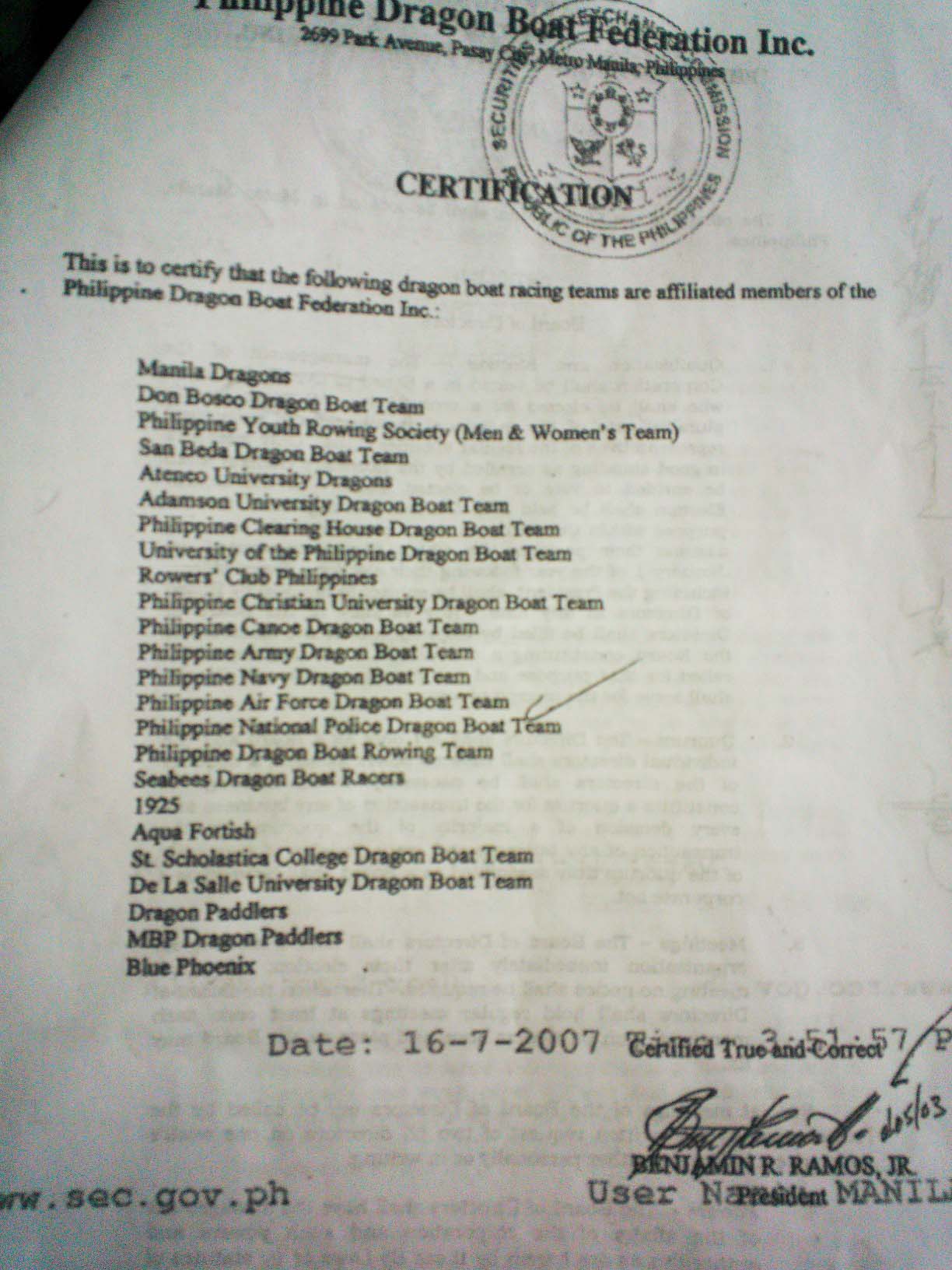
Two years later, in 2005, the Philippines once again hosted the SEA Games, where the National Team bagged all the gold medals for dragon boat. They followed that up with record-breaking times at the Sydney and Prague World Championships in 2007 and 2009, respectively. The year 2005 also saw the Olympic Council of Asia’s (OCA) declaration that ADBF would be the governing body for the sport in Asia. IDBF’s authority was further cemented when Sport Accord, the organization governing the world’s sports federations, recognized dragon boat as an independent sport in 2007. Back home, it seemed that PDBF’s authority had been firmly established.
Under the Philippine Canoe-Kayak Federation
In 2011, industrialist and former congressman Peping Cojuangco assumed the presidency of the Philippine Olympic Commission (POC). Under his leadership, the POC revoked PDBF’s NSA (National Sport Association) status and declared the Philippine Canoe-Kayak Federation in charge of dragon boat. This meant that PDBF would no longer receive official government assistance for any of their activities. Any teams that PDBF would field in international championships would not be considered official Philippine representatives. These developments provoked a well-publicized uproar among members of the dragon boat community.
The POC stated that the decision was made after a directive from the IOC to assign dragon boat to canoe-kayak, for two reasons: first, IDBF had yet to be admitted to the IOC because they did not meet the minimum number (75) of member countries at the time; and second, the IOC was merging other sports, like diving and water polo with swimming, and aerobics with gymnastics, and merely applying this to dragon boat.
This rationalization is unacceptable to Benjie Ramos and the rest of the remaining PDBF administrators and teams. He cites the Sport Accord’s 2007 international congress in Beijing, where IDBF made a bid for autonomy. Previously, the International Canoe Federation (ICF) had successfully blocked attempts by IDBF from being accredited by Sport Accord, claiming dragon boat under their umbrella. Chinese representatives exerted their cultural authority over ICF at the Beijing convention, declaring, “What are you talking about, that this is a discipline of canoeing? It’s been with us for thousands and thousands of years! This is a different sport.” IDBF was granted recognition that year.
The way Ramos tells it, the power struggle between dragon boat and canoe-kayak authorities extends beyond specific countries. “Ang conflict ng ICF at IDBF, mabigat din e,” he laments. He speculates that the reason behind canoe-kayak’s persistent claims over dragon boat boils down to funding and sheer marketing prospects. “The more [members] you have in your association, the bigger government support you get. Another thing is, they saw that dragon boat attracts a lot of people. You want to raise funds? You hold a dragon boat festival, sponsors come in. Maybe ICF saw the potential.”
While PDBF has a maintained a vocal support base, most club teams and some members of the National Team have since aligned themselves with PCKF for pragmatic reasons. “It’s because of the financial support… being recognized as official teams,” says Ramos. “Hindi mo rin sila masisisi.” He remains adamant about one thing: that PDBF would not acquiesce to being under PCKF, “because they are the ones recognized by the international federation. Bakit sila papayag kung mapapahiya sila? They’ll lose face.” Now that IDBF has 74 member countries, with more pending membership, Ramos hopes that their eligibility for IOC recognition would strengthen the case for regaining NSA status.
“This is For the Country”
The tentative division between PCKF and PDBF factions persists, with PCKF teams training at the Manila Yacht Club docks while PDBF trains at the opposite end of the bay, loading at Manila Ocean Park. The PCKF National Team remains on the government’s retainer, with allowances and assigned quarters at the Rizal Sports Complex. Their most recent international competition, last year’s ICF-sponsored Dragon Boat World Championships in Milan, garnered six gold medals and one silver. PCKF is also currently in charge of officiating most local and national regattas, including the Philippine National Games and the Boracay International Dragon Boat Festivals, to name the largest.
Meanwhile, PDBF is backed by a well-oiled publicity machine to support their activities, fueled by endorsements of their primary sponsor, Cobra Energy Drink. A record-setting victory at the 1000-meter small boat event at the 2011 IDBF World Championships in Tampa, Florida also boosted their public image. This past July, the Cobra PDBF Team bagged silver and bronze medals at the 2013 IDBF World Championships in Hungary.
Today, both PCKF and PDBF continue to promote the sport of dragon boat through their efforts in organizing races throughout the year. If anything good has come out of the POC debacle, it’s an increased public awareness of dragon boat as a sport that Filipinos can dominate. Local governments have begun fielding their own provincial teams, including formidable crews from Rizal, Bicol, Laguna, and the Visayas region. Dragon boat races outside of Manila have become lucrative tourism prospects, as seen in the successful La Laguna and Cam Sur festivals. With all these positive developments, Benjie Ramos remains optimistic that politics aside, it’s the sport and the athletes that matter. When speaking of the possibility of a united PCKF and PDBF, he says, “kung sino ang magaling, yun ang kukunin. This is for the country, no?”

